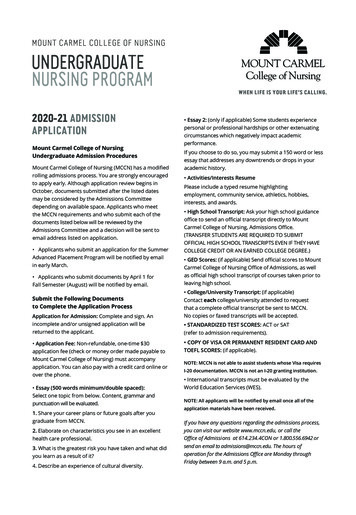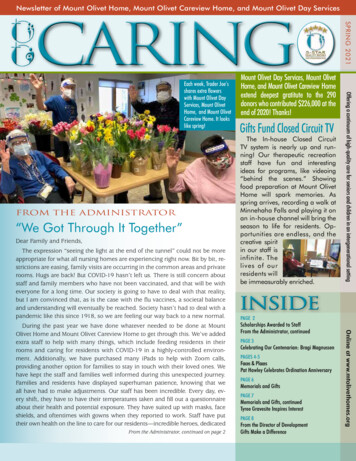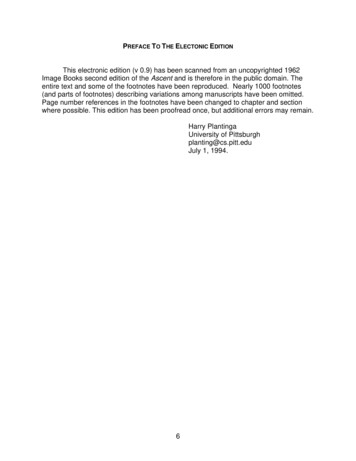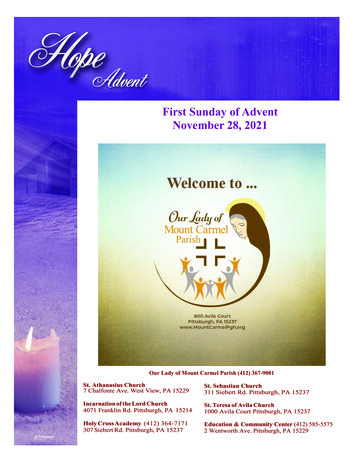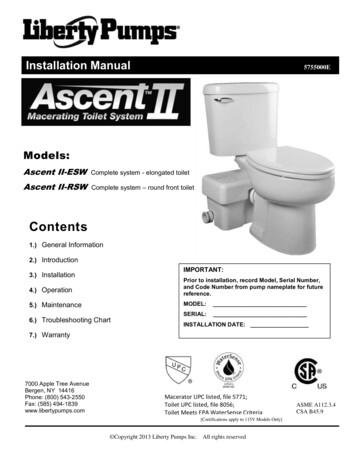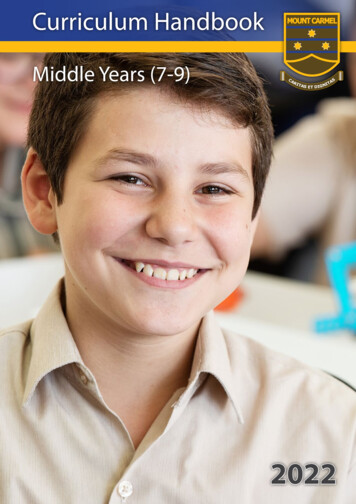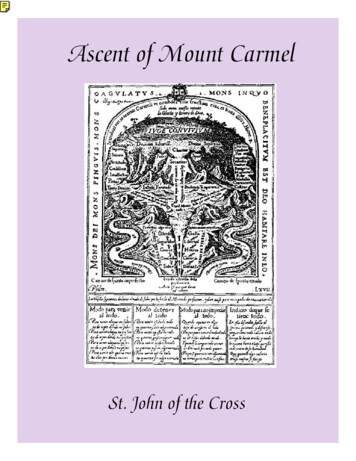
Transcription
Ascent of Mount CarmelSt. John of the Cross
Ascent of Mount CarmelSt. John of the Cross
Ascent of Mount CarmelSt. John of the CrossTable of ContentsAbout This Book. . . . . . . . . . . . . . . . . . . . . . . . . . . . . . . . . . . . . . p. iiTitle Page. . . . . . . . . . . . . . . . . . . . . . . . . . . . . . . . . . . . . . . . . . p. 1Prefatory. . . . . . . . . . . . . . . . . . . . . . . . . . . . . . . . . . . . . . . . . . . p. 3Cover Text. . . . . . . . . . . . . . . . . . . . . . . . . . . . . . . . . . . . . . . . . p. 3Preface To The Electronic Edition. . . . . . . . . . . . . . . . . . . . . . . . . p. 4Translator’s Preface To The First Edition. . . . . . . . . . . . . . . . . . . . . p. 4Translator’s Preface To The Second Edition. . . . . . . . . . . . . . . . . . . p. 8Principal Abbreviations. . . . . . . . . . . . . . . . . . . . . . . . . . . . . . . . p. 9An Outline Of The Life Of St. John. . . . . . . . . . . . . . . . . . . . . . . . . p. 10General Introduction To The Works Of St. John Of The Cross. . . . . . . p. 13Introduction. . . . . . . . . . . . . . . . . . . . . . . . . . . . . . . . . . . . . . . . p. 45The Manuscripts. . . . . . . . . . . . . . . . . . . . . . . . . . . . . . . . . . . . . p. 48Ascent of Mount Carmel. . . . . . . . . . . . . . . . . . . . . . . . . . . . . . . . p. 52Argument. . . . . . . . . . . . . . . . . . . . . . . . . . . . . . . . . . . . . . . . . p. 52Stanzas. . . . . . . . . . . . . . . . . . . . . . . . . . . . . . . . . . . . . . . . . . . p. 52Prologue. . . . . . . . . . . . . . . . . . . . . . . . . . . . . . . . . . . . . . . . . . p. 53Book The First. Wherein is described the nature of dark night and hownecessary it is to pass through it to Divine union; and in particular this bookdescribes the dark night of sense, and desire, and the evils which these workin the soul. . . . . . . . . . . . . . . . . . . . . . . . . . . . . . . . . . . . . . . . . . p. 56Book the First. . . . . . . . . . . . . . . . . . . . . . . . . . . . . . . . . . . . . . p. 56Chapter I. Sets down the first stanza. Describes two different nights throughwhich spiritual persons pass, according to the two parts of man, the lowerand the higher. Expounds the stanza which follows. . . . . . . . . . . . . . p. 56Chapter II. Explains the nature of this dark night through which the soulsays that it has passed on the road to union. . . . . . . . . . . . . . . . . . . p. 57Chapter III. Speaks of the first cause of this night, which is that of theprivation of the desire in all things, and gives the reason for which it iscalled night. . . . . . . . . . . . . . . . . . . . . . . . . . . . . . . . . . . . . . . . p. 59Chapter IV. Wherein is declared how necessary it is for the soul truly topass through this dark night of sense, which is mortification of desire, inorder that it may journey to union with God. . . . . . . . . . . . . . . . . . . p. 60Chapter V. Wherein the aforementioned subject is treated and continued,and it is shown by passages and figures from Holy Scripture how necessaryp. 64iii
Ascent of Mount CarmelSt. John of the Crossit is for the soul to journey to God through this dark night of the mortificationof desire in all things. . . . . . . . . . . . . . . . . . . . . . . . . . . . . . . . . .Chapter VI. Wherein are treated two serious evils caused in the soul bythe desires, the one evil being privative and the other positive. . . . . . . p. 67Chapter VII. Wherein is shown how the desires torment the soul. This isproved likewise by comparison and quotations. . . . . . . . . . . . . . . . . p. 69Chapter VIII. Wherein is shown how the desires darken and blind thesoul. . . . . . . . . . . . . . . . . . . . . . . . . . . . . . . . . . . . . . . . . . . . . p. 71Chapter IX. Wherein is described how the desires defile the soul. This isproved by comparisons and quotations from Holy Scripture. . . . . . . . . p. 74Chapter X. Wherein is described how the desires weaken the soul in virtueand make it lukewarm. . . . . . . . . . . . . . . . . . . . . . . . . . . . . . . . . p. 76Chapter XI. Wherein it is proved necessary that the soul that would attainto Divine union should be free from desires, however slight they be. . . . p. 78Chapter XII. Which treats of the answer to another question, explainingwhat the desires are that suffice to cause the evils aforementioned in thesoul. . . . . . . . . . . . . . . . . . . . . . . . . . . . . . . . . . . . . . . . . . . . . p. 81Chapter XIII. Wherein is described the manner and way which the soulmust follow in order to enter this night of sense. . . . . . . . . . . . . . . . . p. 83Chapter XIV. Wherein is expounded the second line of the stanza. . . . . p. 86Chapter XV. Wherein are expounded the remaining lines of theaforementioned stanza. . . . . . . . . . . . . . . . . . . . . . . . . . . . . . . . p. 87Book The Second. Wherein is treated the proximate means of ascending tounion with God, which is faith; and wherein therefore is described the secondpart of this night, which, as we said, belongs to the spirit, and is containedin the second stanza, which is as follows. . . . . . . . . . . . . . . . . . . . . . p. 88Chapter I. Stanza The Second. . . . . . . . . . . . . . . . . . . . . . . . . . . p. 88Chapter II. Which begins to treat of the second part or cause of this night,which is faith. Proves by two arguments how it is darker than the first andthan the third. . . . . . . . . . . . . . . . . . . . . . . . . . . . . . . . . . . . . . . p. 89Chapter III. How faith is dark night to the soul. This is proved with argumentsand quotations and figures from Scripture. . . . . . . . . . . . . . . . . . . . p. 90Chapter IV. Treats in general of how the soul likewise must be in darkness,in so far as this rests with itself, to the end that it may be effectively guidedby faith to the highest contemplation. . . . . . . . . . . . . . . . . . . . . . . . p. 93Chapter V. Wherein is described what is meant by union of the soul withGod. A comparison is given. . . . . . . . . . . . . . . . . . . . . . . . . . . . . p. 95Chapter VI. Wherein is described how it is the three theological virtues thatperfect the three faculties of the soul, and how the said virtues produceemptiness and darkness within them. . . . . . . . . . . . . . . . . . . . . . . p. 99iv
Ascent of Mount CarmelSt. John of the CrossChapter VII. Wherein is described how strait is the way that leads to eternallife and how completely detached and disencumbered must be those thatwill walk in it. We begin to speak of the detachment of theunderstanding. . . . . . . . . . . . . . . . . . . . . . . . . . . . . . . . . . . . . . p. 101Chapter VIII. Which describes in a general way how no creature and noknowledge that can be comprehended by the understanding can serve asa proximate means of Divine union with God. . . . . . . . . . . . . . . . . . p. 105Chapter IX. How faith is the proximate and proportionate means to theunderstanding whereby the soul may attain to the Divine union of love.This is proved by passages and figures from Divine Scripture. . . . . . . p. 108Chapter X. Wherein distinction is made between all apprehensions andtypes of knowledge which can be comprehended by theunderstanding. . . . . . . . . . . . . . . . . . . . . . . . . . . . . . . . . . . . . . p. 109Chapter XI. Of the hindrance and harm that may be caused byapprehensions of the understanding which proceed from that which issupernaturally represented to the outward bodily senses; and how the soulis to conduct itself therein. . . . . . . . . . . . . . . . . . . . . . . . . . . . . . . p. 110Chapter XII. Which treats of natural imaginary apprehensions. Describestheir nature and proves that they cannot be a proportionate means ofattainment to union with God. Shows the harm which results from inabilityto detach oneself from them. . . . . . . . . . . . . . . . . . . . . . . . . . . . . p. 115Chapter XIII. Wherein are set down the signs which the spiritual personwill find in himself whereby he may know at what season it behoves himto leave meditation and reasoning and pass to the state ofcontemplation. . . . . . . . . . . . . . . . . . . . . . . . . . . . . . . . . . . . . . p. 118Chapter XIV. Wherein is proved the fitness of these signs, and the reasonis given why that which has been said in speaking of them is necessary toprogress. . . . . . . . . . . . . . . . . . . . . . . . . . . . . . . . . . . . . . . . . . p. 120Chapter XV. Wherein is explained how it is sometimes well for progressiveswho are beginning to enter upon this general knowledge of contemplationto make use of natural reasoning and the work of the naturalfaculties. . . . . . . . . . . . . . . . . . . . . . . . . . . . . . . . . . . . . . . . . . p. 126Chapter XVI. Which treats of the imaginary apprehensions that aresupernaturally represented in the fancy. Describing how they cannot servethe soul as a proximate means to union with God. . . . . . . . . . . . . . . p. 128Chapter XVII. Wherein is described the purpose and manner of God in Hiscommunication of spiritual blessings to the soul by means of the senses.Herein is answered the question which has been referred to. . . . . . . . p. 133Chapter XVIII. Which treats of the harm that certain spiritual masters maydo to souls when they direct them not by a good method with respect top. 137v
Ascent of Mount CarmelSt. John of the Crossthe visions aforementioned. Describes also how these visions may causedeception even though they be of God. . . . . . . . . . . . . . . . . . . . . .Chapter XIX. >Wherein is expounded and proved how, although visionsand locutions which come from God are true, we may be deceived aboutthem. This is proved by quotations from Divine Scripture. . . . . . . . . . p. 139Chapter XX. Wherein is proved by passages from Scripture how the sayingsand words of God, though always true, do not always rest upon stablecauses. . . . . . . . . . . . . . . . . . . . . . . . . . . . . . . . . . . . . . . . . . . p. 145Chapter XXI. Wherein is explained how at times, although God answersthe prayers that are addressed to Him, He is not pleased that we shoulduse such methods. It is also shown how, although He condescend to usand answer us, He is oftentimes wroth. . . . . . . . . . . . . . . . . . . . . . p. 148Chapter XXII. Wherein is solved a difficulty — namely, why it is not lawful,under the law of grace, to ask anything of God by supernatural means, asit was under the old law. This solution is proved by a passage from SaintPaul. . . . . . . . . . . . . . . . . . . . . . . . . . . . . . . . . . . . . . . . . . . . . p. 154Chapter XXIII. Which begins to treat of the apprehensions of theunderstanding that come in a purely spiritual way, and describes theirnature. . . . . . . . . . . . . . . . . . . . . . . . . . . . . . . . . . . . . . . . . . . p. 161Chapter XXIV. Which treats of two kinds of spiritual vision that comesupernaturally. . . . . . . . . . . . . . . . . . . . . . . . . . . . . . . . . . . . . . p. 163Chapter XXV. Which treats of revelations, describing their nature andmaking a distinction between them. . . . . . . . . . . . . . . . . . . . . . . . . p. 166Chapter XXVI. Which treats of the intuition of naked truths in theunderstanding, explaining how they are of two kinds and how the soul isto conduct itself with respect to them. . . . . . . . . . . . . . . . . . . . . . . p. 167Chapter XXVII. Which treats of the second kind of revelation, namely, thedisclosure of hidden secrets. Describes the way in which these may assistthe soul toward union with God, and the way in which they may be ahindrance; and how the devil may deceive the soul greatly in thismatter. . . . . . . . . . . . . . . . . . . . . . . . . . . . . . . . . . . . . . . . . . . p. 173Chapter XXVIII. Which treats of interior locutions that may come to thespirit supernaturally. Says of what kinds they are. . . . . . . . . . . . . . . p. 175Chapter XXIX. Which treats of the first kind of words that the recollectedspirit sometimes forms within itself. Describes the cause of these and theprofit and the harm which there may be in them. . . . . . . . . . . . . . . . p. 176Chapter XXX. Which treats of the interior words that come to the spiritformally by supernatural means. Warns the reader of the harm which theymay do and of the caution that is necessary in order that the soul may notbe deceived by them. . . . . . . . . . . . . . . . . . . . . . . . . . . . . . . . . . p. 180vi
Ascent of Mount CarmelSt. John of the CrossChapter XXXI. Which treats of the substantial words that come interiorlyto the spirit. Describes the difference between them and formal words, andthe profit which they bring and the resignation and respect which the soulmust observe with regard to them. . . . . . . . . . . . . . . . . . . . . . . . . p. 182Chapter XXXII. Which treats of the apprehensions received by theunderstanding from interior feelings which come supernaturally to the soul.Describes their cause, and the manner wherein the soul must conduct itselfso that they may not obstruct its road to union with God. . . . . . . . . . . p. 184Book The Third. Which treats of the purgation of the active night of thememory and will. Gives instruction how the soul is to behave with respectto the apprehensions of these two faculties, that it may come to union withGod, according to the two faculties aforementioned, in perfect hope andcharity. . . . . . . . . . . . . . . . . . . . . . . . . . . . . . . . . . . . . . . . . . . . p. 187Chapter I. . . . . . . . . . . . . . . . . . . . . . . . . . . . . . . . . . . . . . . . . p. 187Chapter II. Which treats of the natural apprehensions of the memory anddescribes how the soul must be voided of them in order to be able to attainto union with God according to this faculty. . . . . . . . . . . . . . . . . . . . p. 187Chapter III. Wherein are described three kinds of evil which come to thesoul when it enters not into darkness with respect to knowledge andreflections in the memory. Herein is described the first. . . . . . . . . . . . p. 192Chapter IV. Which treats of the second kind of evil that may come to thesoul from the devil by way of the natural apprehensions of thememory. . . . . . . . . . . . . . . . . . . . . . . . . . . . . . . . . . . . . . . . . . p. 194Chapter V. Of the third evil which comes to the soul by way of the distinctnatural knowledge or the memory. . . . . . . . . . . . . . . . . . . . . . . . . p. 195Chapter VI. Of the benefits which come to the soul from forgetfulness andemptiness of all thoughts and knowledge which it may have in a naturalway with respect to the memory. . . . . . . . . . . . . . . . . . . . . . . . . . p. 196Chapter VII. Which treats or the second kind or apprehension of the memory— namely, imaginary apprehensions — and of supernaturalknowledge. . . . . . . . . . . . . . . . . . . . . . . . . . . . . . . . . . . . . . . . p. 197Chapter VIII. Of the evils which may be caused in the soul by the knowledgeof supernatural things, if it reflect upon them. Says how many these evilsa r e . . . . . . . . . . . . . . . . . . . . . . . . . . . . . . . . . . . . . . . . . . . . . . p. 198Chapter IX. Of the second kind of evil, which is the peril of falling intoself-esteem and vain presumption. . . . . . . . . . . . . . . . . . . . . . . . . p. 199Chapter X. Of the third evil that may come to the soul from the devil, throughthe imaginary apprehensions of the memory. . . . . . . . . . . . . . . . . . p. 200vii
Ascent of Mount CarmelSt. John of the CrossChapter XI. Of the fourth evil that comes to the soul from the distinctsupernatural apprehensions of the memory, which is the hindrance that itinterposes to union. . . . . . . . . . . . . . . . . . . . . . . . . . . . . . . . . . . p. 201Chapter XII. Of the fifth evil that may come to the soul in supernaturalimaginary forms and apprehensions, which is a low and unseemly judgmentor God. . . . . . . . . . . . . . . . . . . . . . . . . . . . . . . . . . . . . . . . . . . p. 202Chapter XIII. Of the benefits which the soul receives through banishingfrom itself the apprehensions of the imagination. This chapter answers acertain objection and explains a difference which exists betweenapprehensions that are imaginary, natural and supernatural. . . . . . . . p. 203Chapter XIV. Which treats of spiritual knowledge in so far as it may concernthe memory. . . . . . . . . . . . . . . . . . . . . . . . . . . . . . . . . . . . . . . . p. 207Chapter XV. Which sets down the general method whereby the spiritualperson must govern himself with respect to this sense. . . . . . . . . . . . p. 207Chapter XVI. Which begins to treat of the dark night of the will. Makes adivision between the affections of the will. . . . . . . . . . . . . . . . . . . . p. 209Chapter XVII. Which begins to treat of the first affections of the will.Describes the nature of joy and makes a distinction between the things inwhich the will can rejoice. . . . . . . . . . . . . . . . . . . . . . . . . . . . . . . p. 211Chapter XVIII. Which treats of joy with respect to temporal blessings.Describes how joy in them must be directed to God. . . . . . . . . . . . . . p. 211Chapter XIX. Of the evils that may befall the soul when it sets its rejoicingupon temporal blessings. . . . . . . . . . . . . . . . . . . . . . . . . . . . . . . p. 214Chapter XX. Of the benefits that come to the soul from its withdrawal ofjoy from temporal things. . . . . . . . . . . . . . . . . . . . . . . . . . . . . . . . p. 217Chapter XXI. Which describes how it is vanity to set the rejoicing of the willupon the good things of nature, and how the soul must direct itself, bymeans of them, to God. . . . . . . . . . . . . . . . . . . . . . . . . . . . . . . . p. 219Chapter XXII. Of the evils which come to the soul when it sets the rejoicingof its will upon the good things of nature. . . . . . . . . . . . . . . . . . . . . p. 221Chapter XXIII. Of the benefits which the soul receives from not setting itsrejoicing upon the good things of nature. . . . . . . . . . . . . . . . . . . . . p. 223Chapter XXIV. Which treats of the third kind of good thing whereon the willmay set the affection of rejoicing, which kind pertains to sense. Indicateswhat these good things are and of how many kinds, and how the will hasto be directed to God and purged of this rejoicing. . . . . . . . . . . . . . . p. 225Chapter XXV. Which treats of the evils that afflict the soul when it desiresto set the rejoicing of its will upon the good things of sense. . . . . . . . . p. 227viii
Ascent of Mount CarmelSt. John of the CrossChapter XXVI. Of the benefits that come to the soul from self-denial inrejoicing as to things of sense, which benefits are spiritual andtemporal. . . . . . . . . . . . . . . . . . . . . . . . . . . . . . . . . . . . . . . . . . p. 228Chapter XXVII. Which begins to treat of the fourth kind of good — namely,the moral. Describes wherein this consists, and in what manner joy of thewill therein is lawful. . . . . . . . . . . . . . . . . . . . . . . . . . . . . . . . . . . p. 230Chapter XXVIII. Of seven evils into which a man may fall if he set therejoicing of his will upon moral good. . . . . . . . . . . . . . . . . . . . . . . . p. 232Chapter XXIX. Of the benefits which come to the soul through thewithdrawal of its rejoicing from moral good. . . . . . . . . . . . . . . . . . . . p. 235Chapter XXX. Which begins to treat of the fifth kind of good wherein thewill may rejoice, which is the supernatural. Describes the nature of thesesupernatural good things, and how they are distinguished from the spiritual,and how joy in them is to be directed to God. . . . . . . . . . . . . . . . . . p. 236Chapter XXXI. Of the evils which come to the soul when it sets the rejoicingof the will upon this kind of good. . . . . . . . . . . . . . . . . . . . . . . . . . p. 238Chapter XXXII. Of two benefits which are derived from the renunciation ofrejoicing in the matter of the supernatural graces. . . . . . . . . . . . . . . p. 241Chapter XXXIII. Which begins to treat of the sixth kind of good wherein thesoul may rejoice. Describes its nature and makes the first division underthis head. . . . . . . . . . . . . . . . . . . . . . . . . . . . . . . . . . . . . . . . . p. 242Chapter XXXIV. Of those good things of the spirit which can be distinctlyapprehended by the understanding and the memory. Describes how thewill is to behave in the matter of rejoicing in them. . . . . . . . . . . . . . . p. 243Chapter XXXV. Of the delectable spiritual good things which can bedistinctly apprehended by the will. Describes the kinds of these. . . . . . p. 243Chapter XXXVI. Which continues to treat of images, and describes theignorance which certain persons have with respect to them. . . . . . . . . p. 245Chapter XXXVII. Of how the rejoicing of the will must be directed, by wayof the images, to God, so that the soul may not go astray because of themor be hindered by them. . . . . . . . . . . . . . . . . . . . . . . . . . . . . . . . p. 247Chapter XXXVIII. Continues to describe motive good. Speaks of oratoriesand places dedicated to prayer. . . . . . . . . . . . . . . . . . . . . . . . . . . p. 248Chapter XXXIX. Of the way in which oratories and churches should beused, in order to direct the spirit to God. . . . . . . . . . . . . . . . . . . . . . p. 250Chapter XL. Which continues to direct the spirit to interior recollection withreference to what has been said. . . . . . . . . . . . . . . . . . . . . . . . . . p. 251Chapter XLI. Of certain evils into which those persons fall who givethemselves to pleasure in sensible objects and who frequent places ofdevotion in the way that has been described. . . . . . . . . . . . . . . . . . p. 252ix
Ascent of Mount CarmelSt. John of the CrossChapter XLII. Of three different kinds of place for devotion and of how thewill should conduct itself with regard to them. . . . . . . . . . . . . . . . . . p. 253Chapter XLIII. Which treats of other motives for prayer that many personsuse — namely, a great variety of ceremonies. . . . . . . . . . . . . . . . . . p. 254Chapter XLIV. Of the manner wherein the rejoicing and strength of the willmust be directed to God through these devotions. . . . . . . . . . . . . . . p. 255Chapter XLV. Which treats of the second kind of distinct good, wherein thewill may rejoice vainly. . . . . . . . . . . . . . . . . . . . . . . . . . . . . . . . . p. 258Indexes. . . . . . . . . . . . . . . . . . . . . . . . . . . . . . . . . . . . . . . . . . . . p. 260Index of Scripture References. . . . . . . . . . . . . . . . . . . . . . . . . . . . p. 260Latin Words and Phrases. . . . . . . . . . . . . . . . . . . . . . . . . . . . . . . p. 262x
Ascent of Mount CarmelSt. John of the CrossASCENT OFMOUNT CARMELbySaint John of the CrossDOCTOR OF THE CHURCHTHIRD REVISED EDITIONTranslated and edited, with an Introduction,by E. ALLISON PEERSfrom the critical edition ofP. SILVERIO DE SANTA TERESA, C.D.NIHIL OBSTAT: CEORGIVS SMITH, S.T.D., PH.D.CENSOR DEPVTATVSIMPRIMATVR: E. MORROGH BERNARDVICARIVS GENERALISWESTMONASTERII: DIE XXIV SEPTEMBRIS MCMLIITO THEDISCALCED CARMELITES OF CASTILE,WITH ABIDING MEMORIES OF THEIR HOSPITALITY AND KINDNESSIN MADRID, ÁVILA AND BURGOS,
Ascent of Mount CarmelSt. John of the CrossBUT ABOVE ALL OF THEIR DEVOTION TOSAINT JOHN OF THE CROSS,I DEDICATE THIS TRANSLATION2
Ascent of Mount CarmelSt. John of the Cross“the greatest of all mystical theologians”Thus has Thomas Merton described St. John of the Cross, echoing the considered judgment of mostauthorities on the spiritual life; and here in this volume is the great mystic’s most widely appealingwork. Ascent of Mount Carmel is an incomparable guide to the spiritual life — because its authorhas lived his own counsel. Addressed to informed Christians who aspire to grow in union with God,it examines every category of spiritual experience, the spurious as well as the authentic. With rareinsight into human psychology it not only tells how to become more closely united with God, butspells out in vivid detail the pitfalls to avoid.In his Apostolic Letter proclaiming St. John of the Cross a Doctor of the Church, Pope Pius XIwrote that he “points out to souls the way of perfection as though illumined by light from on high,in his limpidly clear analysis of mystical experience. And although [his works] deal with difficultand hidden matters, they are nevertheless replete with such lofty spiritual doctrine and are so welladapted to the understanding of those who study them that they can rightly be called a guide andhandbook for the man of faith who proposes to embrace a life of perfection.”This translation by E. Allison Peers was hailed by the London Times as “the most faithful that hasappeared in any European language.”ST. JOHN OF THE CROSS was perhaps the greatest mystical writer the world has ever known. Bossuet’sfamous tribute — that his writings “possess the same authority in mystical theology as the writingsof St. Thomas possess in dogmatic theology” — remains the most fitting testimonial to his augustplace among spiritual writers.John was born in Castile in 1542 — eve of Spain’s century of greatness, to which he himself wasto add such lustre. He studied under the Jesuits and worked for six years in a hospital. Entering theCarmelites in 1563, he was professed a year later and sent to the great University of Salamanca.He was ordained in 1567 but, shrinking from the apostolate of a priest in the world, consideredentering the Carthusians, a hermitical order.Then came the turning point in his life. He met St. Teresa of Ávila, who was pursuing her epicwork of restoring the pristine, stricter observance of the Carmelite rule. John and two other membersof the order took the vows of the Discalced (or reformed) Carmelites the following year, bindingthemselves to a more rigorous way of life which included daily (and nightly) recitation of the DivineOffice in choir, perpetual abstinence from meat, and additional fasting.Yet his religious vows were but a part of the rigors John was to undergo. The main branch of theorder, the Calced Carmelites, so opposed the Reform that they twice had John kidnapped and jailed— providentially, so it proved, for much of his writing was done in prison.The greater part of his twenty-three years as a Discalced Carmelite, however, was spent in fillinga number of important posts in the order, among them Rector of two colleges, Prior, Definator, andVicar-Provincial. But it was in one of his lesser offices that he was to spend the most decisive yearsof his life: he was confessor to the Carmelite nuns at Ávila, where St. Teresa was Superior.3
Ascent of Mount CarmelSt. John of the CrossThe secret of St. John’s unique contribution to mystical theology was not simply his mysticism,for there have been other mystics; not even his profound grasp of Scripture, dogma, Thomism, andspiritual literature, for there have also been learned mystics. What sets him apart is his extraordinarypoetic vision. To write of mystical experience is to try to express the inexpressible. Because he wasa great poet St. John of the Cross was able, in the realm of mysticism, to push the frontiers of humanexpression beyond where any writer has succeeded in venturing before or since. This poetic intensityis found even in his prose, the major works of which are Ascent of Mount Carmel, Dark Night ofthe Soul, Spiritual Canticle, and Living Flame of Love.St. John of the Cross died in 1591, was beatified less than a century later in 1675, was canonizedin 1726, and was named a Doctor of the Church by Pope Pius XI in 1926.Preface To The Electonic EditionThis electronic edition was scanned in 1994 from an uncopyrighted 1962 Image Books edition.The entire text and some of the footnotes have been reproduced. Nearly 1000 footnotes (and partsof footnotes) describing variations among manuscripts have been omitted. Page number referencesin the footnotes have been changed to chapter and section where possible. This edition has beenproofread once, but additional errors may remain.TRANSLATOR’S PREFACETO THE FIRST EDITIONFOR at least twenty years, a new translation of the works of St. John of the Cross has been an urgentnecessity. The translations of the individual prose works now in general use go back in their originalform to the eighteen-sixties, and, though the later editions of some of them have been submitted toa certain degree of revision, nothing but a complete retranslation of the works from their originalSpanish could be satisfactory. For this there are two reasons.First, the existing translations were never very exact renderings of the original Spanish text evenin the form which held the field when they were first published. Their great merit was extremereadableness: many a disciple of the Spanish mystics, who is unacquainted with the language inwhich they wrote, owes to these translations the comparative ease with which he has mastered themain lines of St. John of the Cross’s teaching. Thus for the general reader they were of great utility;for the student, on the other hand, they have never been entirely adequate. They paraphrase difficultexpressions, omit or add to parts of individual sentences in order (as it seems) to facilitatecomprehension of the general drift of the passages in which these occur, and frequently retranslate4
Ascent of Mount CarmelSt. John of the Crossfrom the Vulgate the Saint’s Spanish quotations from Holy Scripture instead of turning into Englishthe quotations themselves, using the text actually before them.A second and more important reason for a new translation, however, is the discovery of freshmanuscripts and the consequent improvements which have been made in the Spanish text of theworks of St. John of the Cross, during the present century. Seventy y
Ascent of Mount Carmel St. John of the Cross. This document has been generated from XSL (Extensible Stylesheet Langua ge) source with RenderX XEP Formatter, version 3.7.3 Client Academic. For more information about XSL, visit the official World Wide Web Cons
